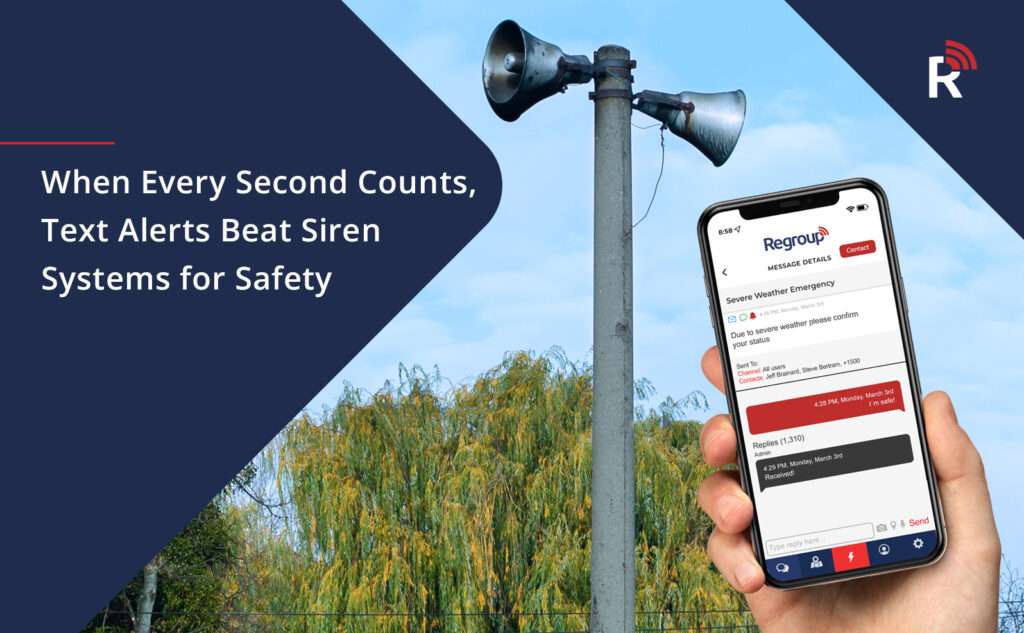
When Every Second Counts, Text Alerts Beat Siren Systems for Safety
When a natural disaster is approaching your town, posing a critical threat to area businesses and homes, time is of the essence. To quickly alert citizens of impending danger, many local officials rely on outdoor notification sirens to get the word out.
But what if citizens can’t hear the warning? Don Campbell, Emergency Management Director of Guilford County, North Carolina, says this is a very real possibility—and it’s one of the reasons he chose not to install emergency sirens in his region.
“Sirens can be loud if you’re underneath them,” says Campbell. “But they’re really not designed to warn you if you’re inside a building.” In a recent Emergency Management article titled Emergency Officials Say Texts, Not Sirens, are More Effective for Tornado Alerts, Campbell explains that as homes are built to be quieter and more energy-efficient than ever, people are much less likely to hear outdoor warning sirens once they’re indoors.
Campbell’s decision was also shaped by the high cost and logistical challenges of siren systems. Guilford County, at 644 square miles, would require the installation of 150 to 300 sirens to provide adequate coverage. “The up-front cost was well into the millions if not tens of millions of dollars,” Campbell says.
This scenario mirrors the situation in many rural communities, such as Kerr County, Texas, where recent flooding has prompted questions about the absence of outdoor sirens. While some may see sirens as the default solution, emergency management experts and county leaders understand that in large, rural areas, these systems offer limited coverage and are often ineffective at reaching people indoors—where they’re most likely to be during a storm or flood. Simply put, the sirens many are asking for may not have changed the outcome.
Instead, local governments across the U.S. have prioritized investing in mass notification systems that deliver alerts directly to residents’ mobile phones, computers, and other devices. These systems offer broader, faster, and more targeted communication—without the massive infrastructure cost or the limitations of outdated warning methods.
Tillamook County, Oregon agrees. Leaders there recently decommissioned 20 emergency alert sirens due to high maintenance costs, choosing instead to focus on modern mobile alerting. The same story was true last year in Clinton County, Iowa where leaders voted unanimously to discontinue siren usage after evaluating their system and discovering it needed $816,000 in updates in addition to $20,000 per year to maintain. And in California, Sonoma County officials faced serious scrutiny—not for lacking sirens—but for not fully utilizing mobile phone alerts during the devastating 2017 wildfires.
When upgrading or enhancing emergency communications, more municipalities are turning to mass notification platforms that offer several key advantages:
Feature 1: Critical Alerting on the Fly
Rapidly issue warnings and coordinate response efforts from anywhere—whether at a desk or in the field—via smartphones, tablets, or landlines.
Feature 2: Automated Severe Weather Alerts
The best modern systems can automatically send severe weather alerts to people in affected areas with built-in integrations with NOAA and the NWS even if emergency staff isn’t immediately available to hit ‘send’. When people already know what the weather is doing, it makes sending evacuation orders or shelter-in-place notifications faster and more effective later on since the situation is clearer for residents during developing emergencies.
Feature 3: Unified Emergency Communications
Reach residents through multiple channels at once—text messages, digital signage, websites, PA systems, and social media—with a single click.
While emergency sirens may still have a place in certain densely populated or urban areas, they are no longer the gold standard for reaching the public in rural or spread-out regions. Cloud-based alerting platforms like Regroup Mass Notification offer speed, reliability, and scalability—ensuring that when seconds matter, communities receive the right information at the right time.
Table of Contents
Categories
- Business
- Transportation
- Small Business
- Manufacturing
- Banking Finance
- Disaster Recovery
- Employee Safety
- Routine Communications
- Mass Notification
- Critical Event Management
- Emergency Preparedness
- Corporate
- Insurance
- Business Continuity
- Business Case Studies
- Uncategorized
- Education
- Regroup Product Guides
- Nonprofit
- Healthcare
- Hospitality
- Government & Public Services
- Our Clients
- Awards
- Blog
- COVID-19
- Safety & Preparedness
- News
- Announcements